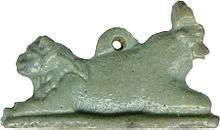Apis (deity)
| Apis | ||||||||||||
|---|---|---|---|---|---|---|---|---|---|---|---|---|
| God of strength and fertility | ||||||||||||
 Statue of Apis, Thirtieth dynasty of Egypt (Louvre) | ||||||||||||
| Name in hieroglyphs |
, or
, or
, or
| |||||||||||
| Symbol | Bull | |||||||||||
In Egyptian mythology, Apis or Hapis (alternatively spelled Hapi-ankh, Egyptian hieroglyphs ⟨ḥjpw⟩, reconstructed as Old Egyptian */ˈħujp?w/ (with unknown final vowel) > Middle Egyptian ˈħeʔp(?w), Coptic: ϩⲁⲡⲉ/ⲓ) is a sacred bull worshipped in the Memphis region. "Apis served as an intermediary between humans and an all-powerful god (originally Ptah, later Osiris, then Atum)."[1]
| Part of a series on |
| Ancient Egyptian religion |
|---|
 |
|
Beliefs |
|
Practices |
|
|
|
Related religions |
|
|
Apis was the most important of all the sacred animals in Egypt, and, as with the others, its importance increased as time went on. Greek and Roman authors have much to say about Apis, the marks by which the black bull-calf was recognized, the manner of his conception by a ray from heaven, his house at Memphis with court for disporting himself, the mode of prognostication from his actions, the mourning at his death, his costly burial, and the rejoicings throughout the country when a new Apis was found. Auguste Mariette's excavation of the Serapeum of Saqqara revealed the tombs of over sixty animals, ranging from the time of Amenhotep III to that of the Ptolemaic dynasty. At first, each animal was buried in a separate tomb with a chapel built above it.
History of worship
The cult of the Apis bull started at the very beginning of Egyptian history, probably as a fertility god connected to grain and the herds. According to Manetho, his worship was instituted by Kaiechos (Nebra?) of the Second Dynasty. Apis is named on very early monuments, but little is known of the divine animal before the New Kingdom. Ceremonial burials of bulls indicate that ritual sacrifice was part of the worship of the early cow deities and a bull might represent a king who became a deity after death. He was entitled "the renewal of the life" of the Memphite god Ptah: but after death he became Osorapis, i.e. the Osiris Apis, just as dead humans were assimilated to Osiris, the king of the underworld. This Osorapis was identified with Serapis of the Hellenistic period and may well be identical with him. Greek writers make the Apis an incarnation of Osiris, ignoring the connection with Ptah.
Apis was the most popular of the three great bull cults of ancient Egypt (the others being the bulls Mnevis and Buchis.) The worship of the Apis bull was continued by the Greeks and after them by the Romans, and lasted until almost 400 CE.
Herald of Ptah

This animal was chosen because it symbolized the king’s courageous heart, great strength, virility, and fighting spirit. The Apis bull was considered to be a manifestation of the pharaoh, as bulls were symbols of strength and fertility, qualities which are closely linked with kingship ("strong bull of his mother Hathor" was a common title for gods and pharaohs).
As early as the time of the Narmer Palette, the king is depicted with an ox tail on one side, and a bull is seen knocking down the walls of a city on the other.
Occasionally, the Apis bull was pictured with her sun-disk between his horns, being one of few deities associated with her symbol. When the disk was depicted on his head with his horns below and the triangle on his forehead, an ankh was suggested. It also is a symbol closely associated with his mother.
Apis was originally the herald (wḥm) of Ptah, the chief god in the area around Memphis. As a manifestation of Ptah, Apis also was considered to be a symbol of the pharaoh, embodying the qualities of kingship. Cattle in the region in which Ptah was worshipped exhibited white patterning on their mainly black bodies, and so a belief grew up that the Apis bull had to have a certain set of markings suitable to its role. It was required to have a white triangle upon its forehead, a white Egyptian vulture wing outline on its back, a scarab mark under its tongue, a white crescent moon shape on its right flank, and double hairs on its tail.
The bull which matched these markings was selected from the herd, brought to a temple, given a harem of cows, and worshipped as an aspect of Ptah. His mother was believed to have been conceived by a flash of lightning from the heavens, or from moonbeams, and also was treated specially. At the temple, Apis was used as an oracle, his movements being interpreted as prophecies. His breath was believed to cure disease, and his presence to bless those around with virility. He was given a window in the temple through which he could be seen, and on certain holidays was led through the streets of the city, bedecked with jewelry and flowers.
%2C_N372.2.jpg)
Burial
Details of the mummification ritual of the sacred bull are written within the Apis papyrus. [2] Sometimes the body of the bull was mummified and fixed in a standing position on a foundation made of wooden planks.
By the New Kingdom, the remains of the Apis bulls were interred at the cemetery of Saqqara. The earliest known burial in Saqqara was performed in the reign of Amenhotep III by his son Thutmose; afterwards, seven more bulls were buried nearby. Ramesses II initiated Apis burials in what is now known as the Serapeum, an underground complex of burial chambers at Saqqara for the sacred bulls, a site used through the rest of Egyptian history into the reign of Cleopatra.

Khaemweset, the priestly son of Ramesses II (c. 1300 BCE), excavated a great gallery to be lined with the tomb chambers; another similar gallery was added by Psamtik I. The careful statement of the ages of the animals in the later instances, with the regnal dates for their birth, enthronement, and death have thrown much light on the chronology from the Twenty-second Dynasty onwards. The name of the mother cow and the place of birth often are recorded. The sarcophagi are of immense size and the burial must have entailed enormous expense. It is therefore remarkable that the priests contrived to bury one of the animals in the fourth year of Cambyses II.
The Apis was a protector of the deceased and linked to the pharaoh. Bulls' horns embellish some of the tombs of ancient pharaohs, and the Apis bull was often depicted on private coffins as a powerful protector. As a form of Osiris, lord of the dead, it was believed that to be under the protection of the Apis bull would give the person control over the four winds in the afterlife.
From bull to man



According to Arrian, Apis was one of the Egyptian Gods for which Alexander the Great performed a sacrifice during his seizure of the country from the Persians.[4] After Alexander's death, his general Ptolemy I Soter made efforts to integrate Egyptian religion with that of their new Hellenic rulers. Ptolemy's policy was to find a deity that should win the reverence alike of both groups, despite the curses of the Egyptian priests against the gods of the previous foreign rulers (i.e. Set who was lauded by the Hyksos). Alexander had attempted to use Amun for this purpose, but he was more prominent in Upper Egypt, which was not so popular with those in Lower Egypt, where the Greeks had stronger influence. Nevertheless, the Greeks had little respect for animal-headed figures, and so a Greek statue was chosen as the idol, and proclaimed as anthropomorphic equivalent of the highly popular Apis. It was named Aser-hapi (i.e. Osiris-Apis), which became Serapis, and was said to be Osiris in full, rather than just his Ka.
The earliest mention of a Serapis is in the authentic death scene of Alexander, from the royal diaries.[5] Here, Serapis has a temple at Babylon, and is of such importance that he alone is named as being consulted on behalf of the dying king. His presence in Babylon would radically alter perceptions of the mythologies of this era, though fortunately, it has been discovered that the unconnected Babylonian god Ea was titled Serapsi, meaning king of the deep, and it is this Serapsi which is referred to in the diaries. The significance of this Serapsi in the Hellenic psyche, due to its involvement in Alexander's death, may have also contributed to the choice of Osiris-Apis as the chief Ptolemaic god.
According to Plutarch, Ptolemy stole the statue from Sinope, having been instructed in a dream by the Unknown God to bring the statue to Alexandria, where the statue was pronounced to be Serapis by two religious experts. One of the experts was one of the Eumolpidae, the ancient family from whose members the hierophant of the Eleusinian Mysteries had been chosen since before history, and the other was the scholarly Egyptian priest Manetho, which gave weight to the judgement both for the Egyptians and the Greeks.
Plutarch may not however be correct, as some Egyptologists allege that the Sinope in the tale is really the hill of Sinopeion, a name given to the site of the already existing Serapeum at Memphis. Also, according to Tacitus, Serapis (i.e. Apis explicitly identified as Osiris in full) had been the god of the village of Rhacotis, before it suddenly expanded into the great capital of Alexandria.
The statue suitably depicted a figure resembling Hades or Pluto, both being kings of the Greek underworld, and was shown enthroned with the modius, which is a basket/grain-measure, on his head, since it was a Greek symbol for the land of the dead. He also held a sceptre in his hand indicating his rulership, with Cerberus, gatekeeper of the underworld, resting at his feet, and it also had what appeared to be a serpent at its base, fitting the Egyptian symbol of rulership, the uraeus.
With his (i.e., Osiris') wife, Isis, and their son (at this point in history) Horus (in the form of Harpocrates), Serapis won an important place in the Greek world, reaching Ancient Rome, with Anubis being identified as Cerberus. The cult survived until 385, when Christians destroyed the Serapeum of Alexandria, and subsequently the cult was forbidden by the Edict of Thessalonica.
Modern use
The pharmaceutical company Novo Nordisk uses the Apis bull as its logo.
See also
References
- ↑ quote: Virtual Egyptian Museum
- ↑ Vos R.L. The Apis Embalming Ritual - P. Vindob. 3873. Peeters publishers 1992, ISBN 978-90-6831-438-0. Retrieved 2015-07-02.
- ↑ "Apis Bull". Walters Art Museum.
- ↑ Anabasis of Alexander, Arrian, from websfor.org
- ↑ Arrian, Anabasis, VII. 26
Further reading
- Dorothy J. Thompson, Memphis Under the Ptolemies, Second Edition. Princeton, 2012.
- Jacques Vandier, "Memphis et le taureau Apis dans le papyrus Jumilhac" (in French), in Jean Sainte Faire Garnot (ed), Mélanges Mariette. Cairo, 1961.
- R. L. Vos, The Apis Embalming Ritual: P. Vindob. 3873. Leuven, 1992.
External links
| Wikimedia Commons has media related to Apis. |
![]() This article incorporates text from a publication now in the public domain: Chisholm, Hugh, ed. (1911). "Apis". Encyclopædia Britannica (11th ed.). Cambridge University Press.
This article incorporates text from a publication now in the public domain: Chisholm, Hugh, ed. (1911). "Apis". Encyclopædia Britannica (11th ed.). Cambridge University Press.